Art Fairs
At Art Basel, Collectors Take a Field Trip—Is It All Just a Rural Fantasy?
With a wheat field in the Messeplatz and a social club on a farm, the art fair has gone cottagecore.

With a wheat field in the Messeplatz and a social club on a farm, the art fair has gone cottagecore.

Louisa Elderton

When I was an undergrad in the early 2000s, taking classes in the pastoral genre was considered to be, how could I put this, kind of a joke.
As a form of literature, art, and music that idealized the lifestyle of the shepherd, herding livestock and bathing in the wisdom of nature, it speaks to a simple, peaceful rural life in direct contrast to the filth and grit of urban cities. We sniffed at the sentimentalism of pastoral ideals, at the romanticized view of the countryside, at the hippie who walked into the class barefoot and with a feather in her hair. We wanted radical Marxism and intersectional feminism, thank you very much! The closest we came to spending serene time in the great outdoors was at raves in the nearby forest—and let’s face it, hugging a tree while on ecstasy doesn’t exactly count in the pastoral tradition.
But the times they are a-changin’. With the ever-increasing temperature of the planet and the climate emergency, our perspective on the urgent vulnerability and sanctity of nature has become increasingly prescient. Throw into the mix the coronavirus lockdowns, which began in 2020 and made the home office a viable alternative-working model, we have seen a renewed lust for the pastoral emerging in the culture at large.
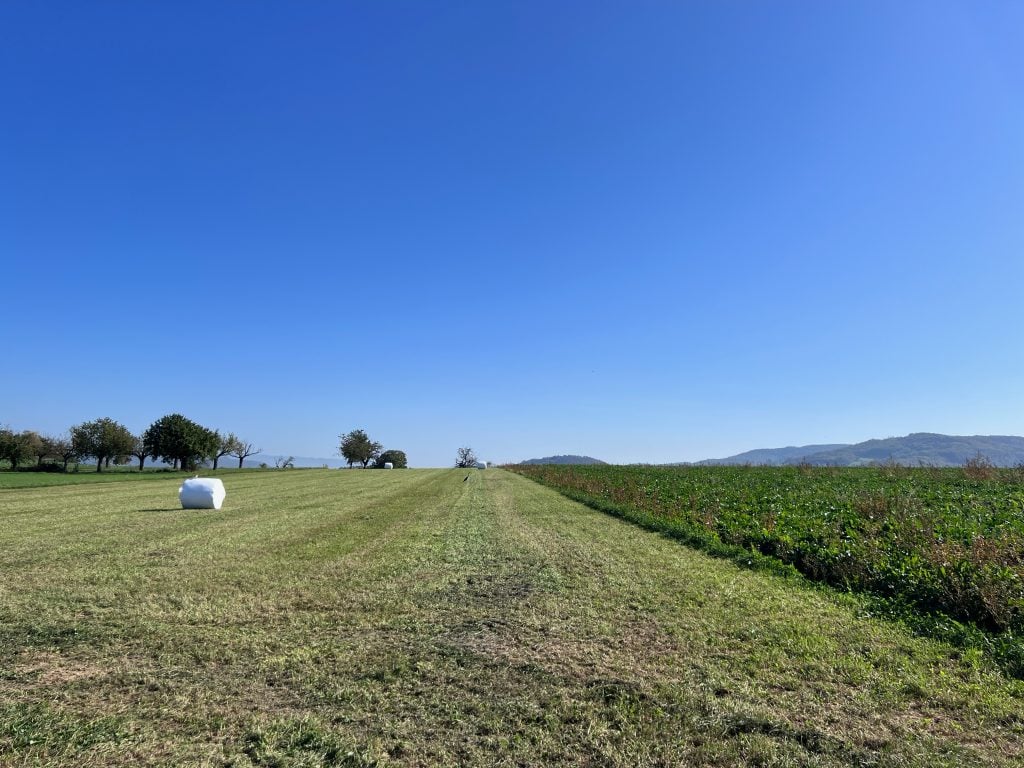
Courtesy Basel Social Club.
The cottagecore trend that swept through TikTok at this time reflected a growing community of Gen Z’ers fantasizing about the idyll of country life. Videos centered on an aesthetic amalgam of crafting activities like making paint from nature (simply take a dead tree trunk and mix it with binder to get ‘Rotting Douglas Fir Red’), turning flowers upside down to become hats for ducklings (admittedly cute), and frolicking in the woods with daisy hairpieces and flowing white dresses (imagine Lana del Ray weeping into the nearest babbling brook).
A wave of criticism ensued, targeting the romantic sanitization of real farm life, not to mention the socio-economic realities of rural poverty, alongside feminist critiques of the patriarchal gender values reinforced by cottagecore. Yet, while the lockdowns have ended and this craze has ebbed, something of the will to return to nature remains.
This too has found expression in the art world. From recent exhibitions such The Barbican’s “RE/SISTERS,” which looked at the relationship between gender and ecology, linking the oppression of women to the degradation of the planet, to the success of Hauser & Wirth’s Somerset gallery—now a destination for contemporary art—to artists like Fernando García-Dory working with aestheticized approaches to agro-ecology, artists, curators, and gallerists are increasingly looking beyond cities to consider modes of social reorganization.
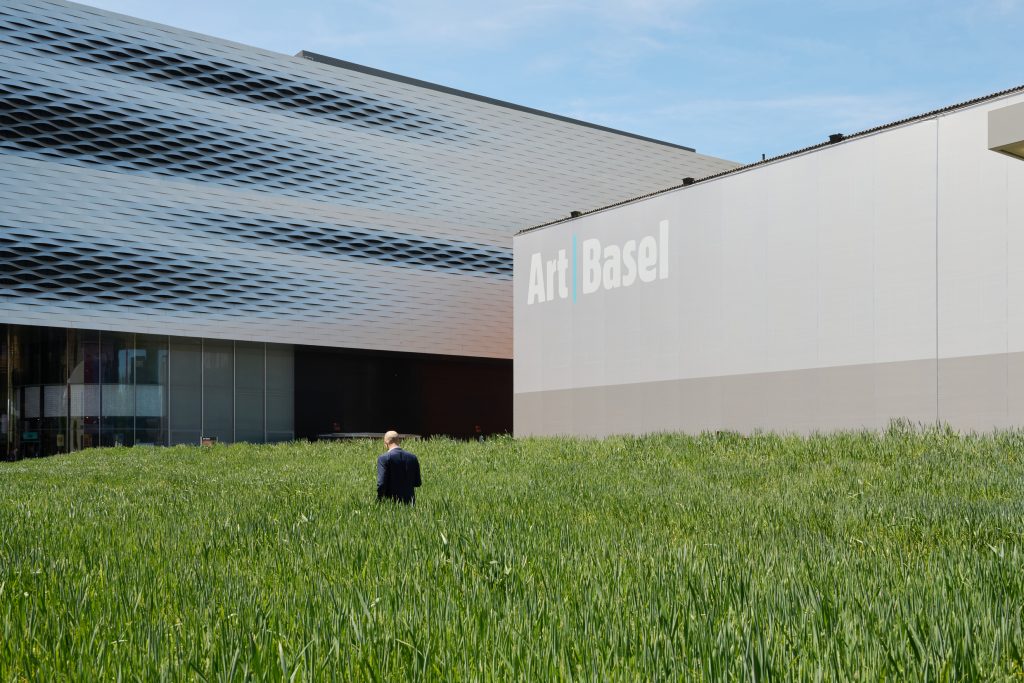
With Agnes Denes’ Honoring Wheatfield – A Confrontation. Courtesy of Art Basel
In an interview with Pablo Larios, who wrote a series of essays for Mousse Magazine about artistic terrain shifting into rural spaces, García-Dory described wanting “to test and develop a form of institution that sustains the rural, that articulates another vision of the rural as a central paradigm of civilization.” So what might this de-centering of art and the city mean, not only in terms of how artists choose to live and the types of art being made, but also, for the market?
At this year’s Art Basel, the eco-pioneer Agnes Denes has installed a wheat field in the Messeplatz in a restaging of her lyrical environmental installation Wheatfield – A Confrontation (1982). Denes’s glowing wheat field was originally developed over a four-month period, planted on a two-acre landfill plot in lower Manhattan, two blocks from New York’s Wall Street and World Trade Center. Two hundred and eighty five furrows were dug into 200 truckloads of fresh soil, with the seeds sewn by hand to ultimately harvest a crop of 1000 pounds of golden wheat. The juxtaposition of this universal symbol of food, hunger, and agriculture with the skyscrapers of capitalism was an indictment of both the skewed values of a neo-liberal economy and of the precarious future of humanity.
Titled Honouring Wheatfield – A Confrontation (2024), Denes’s new iteration of the work covers approximately 1,000 square meters of the concrete plaza, with wheat seeds planted in Euro pallets full of soil, and a path that people can walk through separating the field into two—I’m already envisaging collectors brushing the stalks with their fingertips à la Russell Crowe in Gladiator.
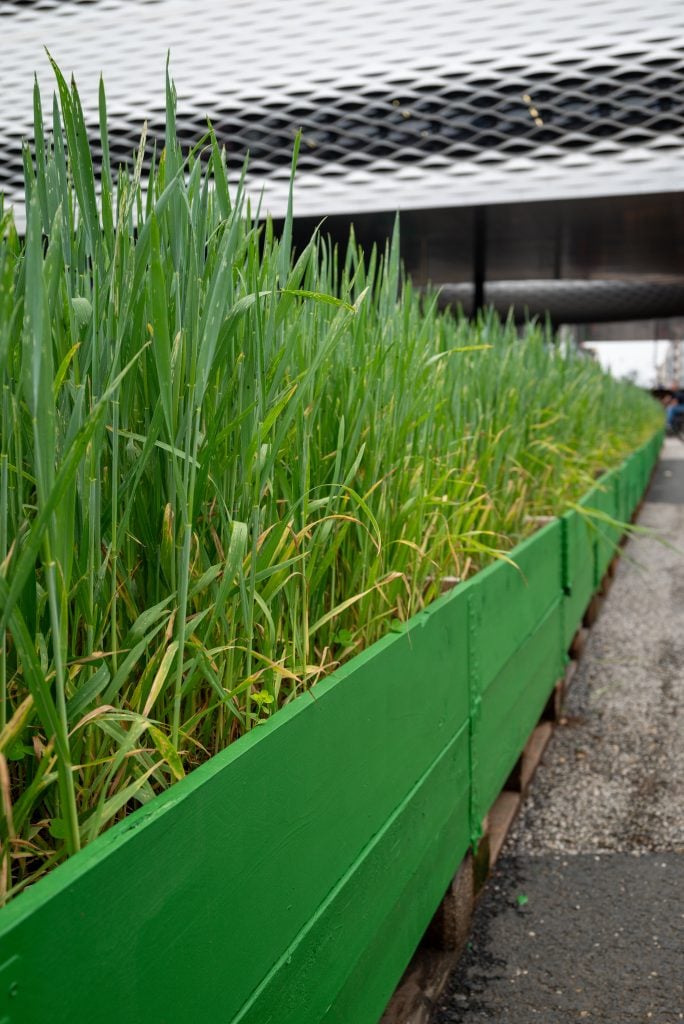
Agnes Denes, detail of Honouring Wheatfield – A Confrontation (2024), installed on the Messeplatz as part of Art Basel. Photo: A. Olsen.
Seen through a political lens, this restaging speaks to a moment in which Russia’s invasion of Ukraine has caused a disruption in the global wheat market. With the crop being one of the most extensively traded grains worldwide and a staple commodity in many countries, food prices have soared amid the destabilization of global food security. Toggling from the macro to the micro, the outdoor installation also looks to the responsibility of the art world to address its own role in the climate crisis, not least the carbon footprint involved in putting on such fairs.
In a recent interview with Christian Viveros-Fauné for Art Basel, Denes said “These works need to be repeated because people are different in cities and rural areas, [they are different in different] countries, and they absorb new knowledge differently.” Honouring Wheatfield – A Confrontation is just that: a confrontation; of the historical mismanagement of our planet amid ecological concerns; of the importance of (art) industries and governments today in committing to carbon-emission reduction; and of our role as individuals in taking responsibility for our planet’s future.
In keeping with all things pastoral, this year Basel Social Club is fully outdoors and has opened its, well, gates, in a field at the edge of the city, where the land is farmed to produce food consumed by Basel’s population. Wild flowers, crops, and even cows are framed by a restaurant at one end of the fair and working stables at the other. The daily activities on the farms continue throughout the week, alongside which participating galleries are presenting artworks and performances that are not exclusively made for indoor spaces.
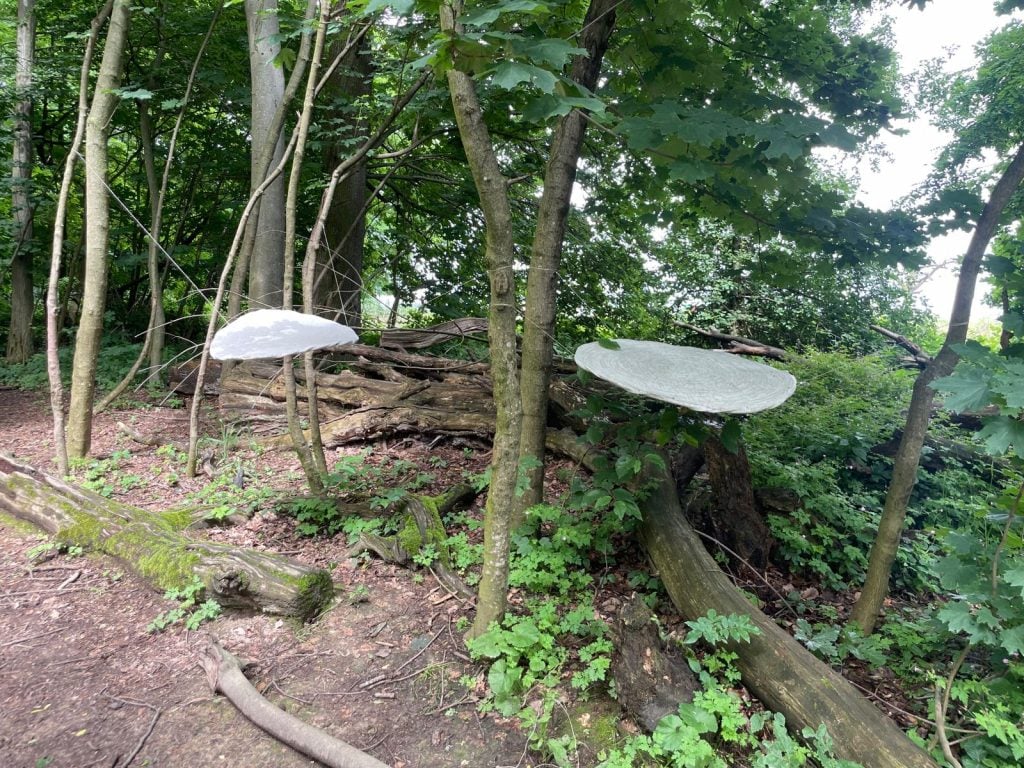
Margaret Raspé, Rain Drums (1988/2023). Courtesy Galerie Molitor.
Galerie Molitor, for example, is presenting the outdoor installation Rain Drums (1988/2023) by Margaret Raspé, in which drums made of hazelnut branches and stretched cotton primed with beeswax, are installed amid the trees, awaiting activation by rainfall. The gallery will also stage the performance Blind Cut (2024), a lawnmower drawing enacted by the artist Vera Flück, after an idea by Raspé first realized in 1987, in which the artist sheered geometric lines into an overgrown garden while blindfolded.
The founders of Basel Social Club said: “We personally dreamt of how nice it would be to bring our experience to the open air: putting our feet in the grass, breathing in the fresh air and realizing that what we have built can take shape in any setting.” While it’s tempting to be cynical about the novelty value of wealthy collectors running through fields of wheat like Theresa May on a naughty day, or riding in tractors saying “That’s hot” in the spirit of Nicole Richie and Paris Hilton’s The Simple Life —an early aughts reality show —there is something to be said for rethinking the parameters of what constitutes an art fair. Yael Salomonowitz, Robbie Fitzpatrick, and Hannah Weinberger are strategically looking beyond the conventional structures of hosting such an event indoors, reinvigorating the lifeless stagnancy and homogeneity of the booth system, and in turn making it a more human experience for collectors and gallerists alike.
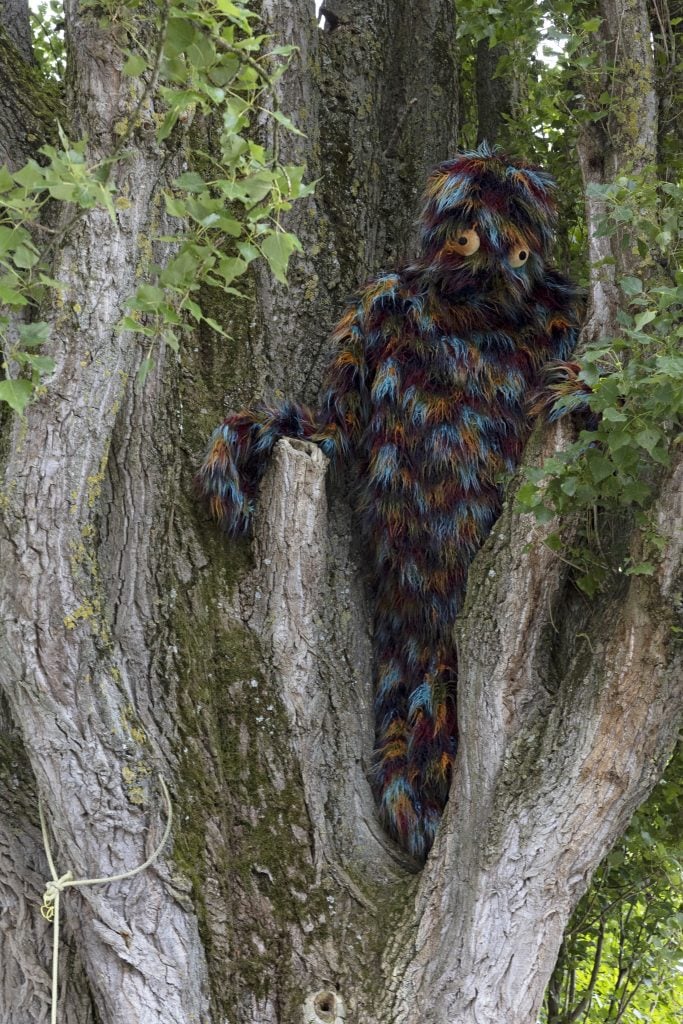
Stefan Tcherepnin installation at Basel Social Club. Photo: Gina Folly.
The artistic concern with how we perceive and interact with our environment, or understand our responsibility towards the planet is nothing new. Neither is the trend of artists leaving the city for the countryside. From the Land Art movement in the 1960s and 1970s to the likes of Derek Jarman making his a home, Prospect Cottage, on the UK’s coast in Dungeness in the late 1980s—as part of which he cultivated a garden that has become its own art world Mecca—artists have been challenging the primacy of cities as a model of living for decades. Many have turned to practices of living off the land, gardening, craft, care, healing, and even Indigenous spiritualism to reformulate misplaced priorities and re-conceptualize the value of life in the age of the Anthropocene.
What is new is the structural apparatus of the art world responding in kind: with museums, galleries, and art fairs also beginning to think outside the box, the role of our art institutions as seemingly immovable edifices shaping our experience of art histories is more malleable than ever, re-framing the rules of how we encounter art. The catch is in the socio-economics of this rural dream. Leaving the city has always been primarily available to the wealthy, what with the cost of property and land, not to mention the privilege of being able to ‘opt out,’ and the advent of an art fair quite literally entering the field is arguably simply a stark symbol of neo-liberal expansionism, using power to co-opt nature. What’s certain is the romanticized view of countryside living is no longer up for ridicule; in fact, perhaps it’s the most coveted prize of all.